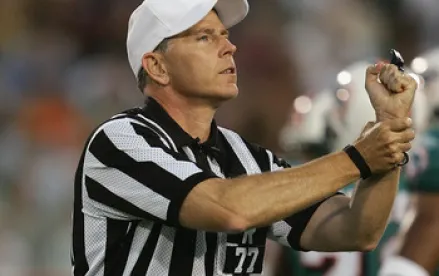The US Court of Appeals for the Second Circuit reinstated copyright infringement claims by sports photographers against commercial users of their photographs, finding that the licenses that the photographers had granted to one of those users did not permit it to grant a sublicense to the other to use those photographs for free. Spinelli, et al. v. National Football League, et al., Case No. 17-cv-0673(2d Cir. Sept. 11, 2018) (Lynch, J).
The plaintiffs are sports photographers who take photos of NFL events. The defendants are the NFL, its various clubs and its photo store, as well as the Associated Press (AP), which served as the NFL’s exclusive licensing agent from 2009 to the present. In order to gain access to photograph NFL events (where NFL trademarks are inevitably displayed), the plaintiffs entered into “contributor agreements” with the AP, which granted the AP broad rights to use and sell their photos. In return, the AP was required to pay a royalty to the plaintiffs consisting of a percentage of the per-image price on sales of the photos.
The AP’s 2009 agreement with the NFL granted the NFL free access to all photos owned by the AP but required the NFL to pay for any “contributor photos,” which included the plaintiffs’ photos. In 2012, without the consent of the plaintiffs, the NFL and the AP negotiated a new contract wherein the NFL had unfettered free access to all “contributor photos.”
Plaintiffs filed this lawsuit after learning that the NFL had been using and selling their photos since 2009 without making any royalty payments. The plaintiffs alleged copyright infringement against the NFL, its photo store and the AP, as well as violations of the Sherman Act and certain state law claims. The defendants moved to dismiss for failure to state a claim, and the district court granted the motion.
It was undisputed that the plaintiffs owned copyrights in the photos used and sold by the NFL, and that the AP had in 2012 granted the NFL a license to use and sell the plaintiffs’ photos. The sole issue for the Second Circuit was whether the plaintiffs’ contributor agreements permitted the AP to grant such a complimentary license to the NFL. Defendants argued that because the plaintiffs’ contributor agreements only required royalty payments on per-image sales, and the license from the AP to the NFL was simply a free license to use the photos, there was no per-image price and therefore no royalties were required.
The Second Circuit rejected this argument. Striving to give “effect and meaning to every term of [the] contract,” the Second Circuit looked at the overall structure of the plaintiffs’ contributor agreements. As the agreements expressly provided for only two exceptions to the requirement that royalties be paid—neither one of which applied—the Court concluded that the agreements were ambiguous as to whether royalties were required in all other situations, including in the AP’s act of granting a free sublicense to the NFL. Once the contributor agreements were found to be ambiguous, extrinsic evidence regarding their interpretation was admissible, including the plaintiffs’ allegations that they had expressly told the AP during negotiations that they were unwilling to grant the NFL complimentary licenses without additional compensation. This dispute over the proper interpretation of the contributor agreements, including whether the agreements allowed the AP to issue a complimentary sublicense to the NFL, required reinstatement of the copyright infringement claims.
The Second Circuit found additional rationale for reinstating the plaintiffs’ claims regarding the NFL’s pre-2012 use of the plaintiffs’ photos. Defendants argued that the plaintiffs’ claims were extinguished by the 2012 contract between the AP and the NFL, which retroactively permitted the NFL complimentary use of all contributor photos. Extending its 2007 holding in Davis v. Blige, the Court said that the AP could not retroactively grant a license that would extinguish the plaintiffs’ already-accrued right to sue for copyright infringement. Rather, the court explained that even if the AP had the right to grant such a complimentary license to the NFL in the first place (which as discussed above was ambiguous), it could not do so retroactively.
In addition, the plaintiffs pleaded antitrust violations. The photographers alleged that the NFL and the AP had colluded to control the commercial market for professional football-related stock photography. Plaintiffs argued that by collectively licensing its intellectual property, the NFL and the NFL teams formed a horizontal conspiracy, operated in conjunction with the AP as their exclusive licensing agent. The plaintiffs alleged that the conspiracy had reduced the output of stock photography for NFL events, and that the aggregate cost to consumers of commercial licenses had increased. In doing so, the plaintiffs defined the relevant market as the market for commercial licenses of NFL event photographs. The Second Circuit rejected these allegations, as plaintiffs failed to allege an adverse effect in the market they had defined. However, the Court suggested that had the plaintiffs pleaded the market as commercial licenses for NFL trademarks, the result might have been different.
Practice Note: To avoid a finding that a contract is ambiguous, consider all the clauses of the contract in relation to each other rather than in isolation. Additionally, the right to sue for copyright infringement cannot be extinguished by a license after it has already accrued. Finally, in allegations of antitrust violations, it is important to define the relevant market correctly, as courts will only assess adverse effects vis-à-vis the market defined in the complaint.
Sara Fernandez also contributed to this article. Sara is an international attorney visiting our Washington, DC office from the law firm of Pérez-Llorca in Spain.



 />i
/>i